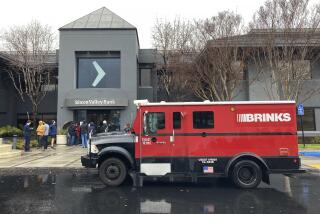How technology helped crack the Kansas City highway shooter case
For almost a month, Kansas Citians lived through what amounted to a horror movie without an ending.
According to the narrative described in court documents, it would take cutting-edge and occasionally controversial law enforcement technology, including license-plate readers, to put an end to the horror show.
The story of this very 21st century hunt began playing out on the tangle of freeways just south of Kansas City, Mo., where, starting in March, one driver after another reported being shot at by a mystery gunman â nobody they knew, for reasons nobody could fathom.
The suspect would later be identified as a driver wearing a black hoodie, a black mask and black sunglasses. His strikes came unpredictably, police discovered, often right before his victims drove onto highway splits and exits. Thatâs when drivers would hear a bang, or suddenly feel a sharp sting.
No one was killed, but one victim was shot in the leg, another in the forearm, another in the calf. On the afternoon of March 29, a driver found a hole from a .380-caliber bullet that had smacked into the rear passenger door by where her daughter was sitting, unharmed.
Police would link at least 12 such attacks to the same .380-caliber weapon before they ultimately arrested 27-year-old Mohammed Pedro Whitaker. On Thursday, they swarmed his home in the south Kansas City suburb of Grandview, where a tributary of highways converge and where many of the attacks had happened.
In Whitakerâs home, police said, they found a .380-caliber handgun. After weeks of fear, they told the press they had their man, and not longer after, Whitaker was charged with 18 felonies. (Itâs not clear if Whitaker, who has not entered a plea, has a lawyer, and he is being held in lieu of $1-million bond.)
No motive has been publicized, and police declined to speculate.
Many crimes have motivations so obvious that itâs not hard for detectives to draw a direct line between a victim and his killer, or at least those who would profit -- financially or emotionally -- from the victimâs death.
But in shootings of this kind, a seemingly plotless series, it was a string of data points that led investigators to Whitaker. Specifically, to his green Dodge Neon.
According to a probable cause statement, authorities got their big break a week before his arrest, on April 9, when a woman came forward to say that she thought she may have been followed by the highway shooter.
She hadnât been shot at. But she recalled a frightening evening in March when a man had stopped his car in front of her, stared at her, and then drove alongside her as the road narrowed until, ultimately, one driver would be forced to go in front of the other.
The woman told police the other driver tried to slow down to get behind her; instead, she braked suddenly and got behind the other driver â also taking the chance to write down his license plate number, which was for an Illinois plate.
Investigators plugged the plate number into a database for license-plate readers. Kansas City police have such automatic readers installed on their cars. Such readers photograph license plates and log the time, location and date of the encounter, feeding millions of plate numbers into a massive database that has drawn criticism from civil-liberties advocates as a potential invasion of privacy. The scanners record any plate they detect, not just those potentially linked to wrongdoing.
In this case, a search for the plate number revealed several hits from 2013, when readers had scanned the plate on vehicles parked in front of an address in Grandview, according to court documents.
At different times in 2013, scanners spotted the plate affixed to at least two different cars at that address. A scanner also captured a photo of a green Neon, sitting in the driveway next to a car with the Illinois plate.
Whatâs more, months earlier, neighbors had reported that a .380-caliber bullet had been shot through the wall of their master bedroom from the direction of the other home.
A day after the woman gave the police the suspectâs license plate number, a plate scanner logged a new hit for the Illinois plate, fixed on a green Dodge Neon.
Police quickly identified the driver as Whitaker, according to court documents. Using specialized search databases, they tracked down his current home address and found data that linked his phone bill to the old address where the license plate had been spotted by scanners months earlier.
In addition to requesting an emergency âpingâ from Sprint to locate Whitakerâs cellphone, police also sought, and obtained, a warrant that allowed them to place a GPS tracking device on Whitakerâs car on April 11, according to court documents. (Warrants are required after a U.S. Supreme Court ruling in 2012 reined in police departmentsâ use of the GPS monitoring of vehicles, though no similar ruling has been handed down for plate scanners.)
Then the stakeout began. On the first day they began following Whitaker, police watched him try, unsuccessfully, to buy a gun off another man in a parking lot, court documents said; they also saw him look at ammunition at Wal-Mart.
Then for days, police say, they watched Whitaker drive erratically, sometimes following other cars on the freeways, at one point braking in front of a surveillance officer and staring him down as the officer pulled away, according to court documents. A day after police watched him veer through lanes of traffic to closely follow a Honda, they arrested him.
When Whitaker was interrogated at headquarters, he said he didnât really know who the now-infamous highway shooter was; then he changed his tune and said he was one of the highway shooterâs victims, according to court documents.
There were bullet holes in his car, the documents said, but they hardly suggested his car had been a target. âHe could also give no explanation for how bullet holes were located on the inside of his vehicle but not the outside,â the documents said.
He also have claimed not to own a gun, documents said, but âgave no explanation for why one was located in his bedroom.â
More to Read
Sign up for Essential California
The most important California stories and recommendations in your inbox every morning.
You may occasionally receive promotional content from the Los Angeles Times.











